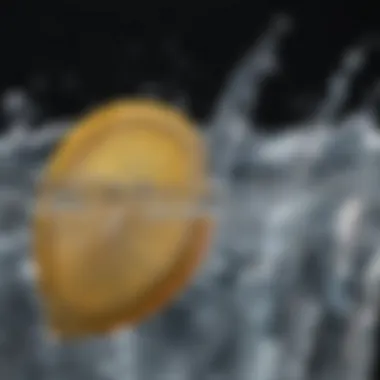Recognizing Dehydration: Signs and Solutions for Watersports


Intro
Dehydration sneaks up like a thief in the night, often going unnoticed until it’s too late. For those diving into watersports, the stakes are even higher as the thrill of the waves can mask the gradual loss of essential fluids. Staying alert to the signs and understanding how to respond can mean the difference between a day filled with excitement or one cut short by exhaustion.
This guide seeks to shine a light on identifying dehydration, especially for enthusiasts who find solace in watersports. By exploring key indicators, from physical symptoms to behavioral changes, we arm ourselves with the ability to gauge our hydration status effectively. Recognizing these signals is not just about safety—it's about maximizing performance and enjoyment.
You might think that drinking water will fix everything, and while that's part of it, it's also crucial to understand other elements at play. Each sport brings unique challenges. Whether you’re surfing, kayaking, or sailing, knowing what signs to look for can help keep the adrenaline high and the hydration levels optimal.
In this comprehensive overview, we will delve into essential techniques and skills that any watersport enthusiast should cultivate. Whether you're a seasoned pro or just getting your feet wet, keeping your hydration game strong ensures that every moment spent on the water is both safe and exhilarating.
Let’s embark on this journey to uncover the physical and behavioral clues of dehydration, arming you with insights to help you navigate your watersports adventures wisely.
Understanding Dehydration
Understanding dehydration is vital for anyone, especially for those who engage in watersports. When participating in high-energy activities like kayaking, sailing, or windsurfing, it's effortless to overlook hydration, often assuming our bodies can handle it. Yet, the reality is much more nuanced. Dehydration can sneak up on you, quietly influencing performance and health without making a racket.
Recognizing and addressing dehydration isn't just about preventing thirst; it's about ensuring safety and maximizing athletic performance. When you comprehend the nuances of hydration, you equip yourself with a tool that can boost endurance, sharpen focus, and enhance recovery. Every sip of water contributes to the larger picture of stamina; without it, performance can diminish faster than a fading sunset.
Definition and Importance of Hydration
Hydration refers to the process of imbibing fluids, primarily water, to maintain the body's fluid balance. This balance influences a multitude of physiological processes. While it may seem that water is just a refreshing drink, it's the backbone of our body’s functionality. Think of hydration as the oil in the engine of a car; without it, performance falters, and strain increases.
Hydration is more than just quenching thirst. It directly correlates with optimizing mental clarity and energy levels. In certain activities, dehydration can lead to disastrous outcomes, such as cramps or heat exhaustion. In various ways, staying hydrated is essential not only for peak performance but also for overall well-being.
The Role of Water in the Body
Water plays several crucial roles in maintaining the body's functions. It facilitates nutrient transport, regulates temperature, and lubricates joints. Consequences of insufficient hydration are felt at multiple levels. Our bodies are roughly 60% water, so as hydration dips, various functions can face complications. Here are a few key roles of water in the body:
- Regulates Body Temperature: Through sweat, water helps maintain temperature during exertion. Without adequate hydration, overheating becomes a significant risk.
- Aids in Digestion: Water is essential for breaking down food and absorbing nutrients, which makes it vital for recovery after rigorous activities.
- Cushions Organs: Proper hydration keeps organs like the kidneys and liver functioning well, filtering waste from our bodies.
Physical Symptoms of Dehydration
Understanding the physical symptoms of dehydration is fundamental for any watersports enthusiast. Recognizing these signs can mean the difference between enjoying a day out on the water and experiencing potential health risks. Dehydration doesn't just sneak up on you; it presents obvious and subtle indications, which can directly impact performance and safety. Whether you're kayaking, sailing, or swimming, knowing your body's signals can help maintain not just your enjoyment but also your overall well-being.
Thirst as a Primary Indicator
Thirst isn’t just a mere inconvenience; it’s your body’s way of raising a red flag. The sensation of thirst is often the first and most straightforward indicator that you might be starting to dehydrate. It’s your body’s instinct to seek out fluids, urging you to replenish what’s been lost. Ignoring this simple signal might lead to more severe symptoms later down the line. In an active environment, particularly during rigorous exercise or high heats, it's easy to miss this subtle hint amid adrenaline and excitement. Prioritizing fluid intake at the first sign of thirst is crucial. Keep in mind that water should be your go-to, but other fluids can also contribute helpful hydration.
Changes in Urine Color and Frequency
Another critical sign of dehydration lies in how often and what color you see in the toilet. Typically, light yellow or pale urine indicates proper hydration. However, if you notice your urine becomes darker, or you're visiting the restroom less frequently, it’s time to consider your intake. This change is a direct reflection of your body's water levels. Don't let dehydration sneak up on you; keeping an eye on urine color is an effective, no-cost method for gauging hydration levels.
Dry Mouth and Skin
A dry mouth and skin can be some of the more bothersome physical symptoms that arise from dehydration. The feeling of a parched mouth is more than just uncomfortable; it signifies a lack of fluid in your system. Your skin could similarly reflect the internal struggles as it may feel dry and less elastic. This not only impacts comfort but can also affect your performance, particularly in activities where grip and control are vital. Remember, if your skin isn’t bouncy, chances are your hydration level needs a boost.
Muscle Cramps and Fatigue
Muscle cramps and general fatigue are perhaps some of the more alarming symptoms. Cramping often rears its ugly head when your body is struggling—whether from dehydration, loss of electrolytes, or a combination of both. Fatigue doesn’t just come from exertion; dehydration can sap your energy, leading to sluggishness and reduced motivation. If you start feeling more tired than usual or catch your muscles tightening unexpectedly, reassess your hydration levels immediately. Staying in tune with your body’s feedback can help you stay ahead of trouble.
"Listening to your body is the first step toward avoiding dehydration and its pitfalls."


Incorporating regular fluid intake into your watersport routine must be second nature. Knowing these physical symptoms not only keeps you safe but also enhances your overall performance. The impact of proper hydration touches every aspect of your time spent on the water.
Behavioral Indicators of Dehydration
Recognizing dehydration isn't just about looking at physical signs; behavioral indicators play a pivotal role too. When engaging in activities like watersports, being aware of how one's mood and cognitive states shift can signal trouble. In this section, we will explore the behavioral changes that may indicate dehydration, emphasizing how these indicators can help athletes and enthusiasts maintain their performance and safety on the water.
Drop in Energy Levels
A noticeable decrease in energy can be one of the first signs that your hydration levels are dipping. When the body lacks adequate water, its ability to function efficiently diminishes. You might see this as a reluctance to partake in activities or an overwhelming sense of fatigue that wasn't there before. This can be particularly troubling for those involved in watersports, where energy is crucial for performance.
Being mindful of how energized you feel can help maintain a proactive approach to hydration. If energy wanes, consider reaching for a drink rather quickly. It’s easy to overlook, but just because you're surrounded by water doesn't mean your body is getting enough of it.
Cognitive Impairment
Dehydration doesn’t merely affect muscles; it can fog up your mental clarity as well. Cognitive impairment can include a range of issues, from difficulty concentrating to lapse in memory. A study in Frontiers in Human Neuroscience demonstrated that even mild dehydration can decrease cognitive performance.
For those who operate under high-stress conditions or require swift decision-making, like during a competitive race or while instructing others, this decline can be dangerous. Keep an eye out for moments of forgetfulness or haziness, as they can be your brain waving a little red flag.
Mood Changes and Irritability
It's no surprise that a lack of hydration can affect mood. We often joke about being "hangry"—hungry and angry—but the same applies to being dehydrated. When you’re low on water, it can lead to irritability, anxiety, or mood swings that can ripple through group activities. In a team setting, one person’s lack of hydration can compromise the collective morale.
Be aware of this behavioral change as it can be both an indicator for you and those around you. Keeping communication channels open about how hydration is impacting your feelings can help foster a supportive environment.
Important Note: Addressing these behavioral markers early can not only improve your experience on the water but can also avert serious health risks.
Being conscious of how you feel mentally and emotionally during activities can help identify dehydration before it manifests in more severe physical symptoms. Always remember that staying hydrated isn’t merely a personal responsibility but also a communal one, essential for safeguarding everyone's experience in the water.
Tools and Techniques for Monitoring Hydration
Monitoring hydration levels is essential, especially for those engaging in rigorous activities like watersports. Staying hydrated not only enhances performance but also safeguards against the risks associated with dehydration. Luckily, several tools and techniques have emerged to assist individuals in keeping a close eye on their fluid intake. These methods vary in sophistication and accessibility but serve the common purpose of promoting awareness about hydration status.
Utilizing Hydration Apps
In our tech-driven era, hydration apps have popped up like daisies in spring. These applications can act as personal hydration coaches, helping users track their daily water intake with ease. Most of them come with user-friendly interfaces, allowing individuals to input their daily water consumption simply. Here are some notable benefits and features of such apps:
- Customization: Many apps allow users to set personalized hydration goals based on their weight, activity level, and climate.
- Reminders: Regular notifications can prompt individuals to drink water throughout the day, combating the forgetfulness that often accompanies busy schedules.
- Tracking Progress: Visualization tools in some apps can clearly depict trends in hydration over time, which enhances self-awareness.
A few popular hydration apps include WaterMinder, MyWater, and Hydro Coach, each offering different functionalities tailored to individual needs. By leveraging such technology, watersport enthusiasts can ensure they avoid the pitfalls of dehydration effortlessly.
Wearing Hydration Monitors
Another stride in hydration monitoring comes in the form of wearable devices. These gadgets provide real-time feedback on one's hydration levels and are increasingly being integrated into fitness trackers. With sensors that measure various biomarkers, they can give users insights into their hydration status at any moment. Noteworthy aspects include:
- Real-time Data: Many hydration monitors can send alerts if the user is becoming dehydrated, prompting immediate action.
- Integration with Other Health Stats: Devices like Fitbit or Garmin can often connect hydration data with other health metrics, creating a holistic picture of one’s overall wellbeing.
- Ease of Use: Unlike maintaining traditional logs, wearing a monitor allows for passive tracking, giving you one less thing to remember.
By investing in such technology, athletes can stay proactive instead of reactive concerning their hydration needs.
Maintaining a Daily Hydration Log
While apps and wearables are modern conveniences, keeping a simple daily hydration log has its merits as well. This age-old technique is straightforward yet effective in raising awareness about water intake. Here’s how keeping such a log can be beneficial:


- Self-Reflection: Writing down daily amounts creates an opportunity for self-evaluation, encouraging individuals to be mindful of their consumption habits.
- Identification of Patterns: Over time, one may notice specific trends linked to performance and hydration, providing insights that help in strategizing future needs.
- Simplicity: A log can be as basic as a notebook or even a section in a planner; it requires no apps or gadgets. Just a pen and paper can be enough to record such crucial data.
In summary, tracking hydration has evolved from simple measurement methods to sophisticated applications and devices, yet some old-school techniques like maintaining a hydration log still hold genuine value. As watersports enthusiasts continue to encounter different conditions and exertion levels, staying hydrated is no longer left to chance. By employing these tools and techniques, individuals can stay one step ahead of dehydration risks and ensure optimal performance on the water.
"Staying hydrated is not just a good habit; it’s a fundamental requirement for anyone looking to excel in their physical endeavors."
Incorporating these methods into a daily routine can significantly enhance awareness of hydration needs, ultimately leading to improved health and performance.
Factors Influencing Dehydration Risk
Understanding the factors that contribute to dehydration is crucial for anyone engaging in watersports. It’s not just about drinking water when you’re thirsty; various elements affect hydration levels. From weather conditions to personal health, knowing these aspects can help you avoid dehydration. Awareness here can improve performance and safety on the water.
Environmental Conditions
The environment plays a significant role in how much fluid you lose and need to replenish. Hot weather can increase the risk of dehydration because you sweat more. For instance, a sunny day at the beach, where temperatures soar, can lead to excessive sweating and evaporation. This condition often goes unnoticed until it’s too late. Also, consider humidity. In high humidity, sweat doesn’t evaporate as effectively, making it harder for the body to cool down. This means you need to drink more water, or better yet, electrolyte drinks to counterbalance the loss of salts.
"Humidity makes us feel hotter. So, when it combines with heat, it becomes a dehydration trap."
Moreover, altitude can also affect hydration needs. At higher altitudes, the air is thinner and drier, causing increased fluid loss through respiration. If you’re hitting those mountain lakes or rivers, don’t forget to adjust your fluid intake accordingly.
Physical Activity and Intensity
Engaging in watersports often involves rigorous activity. The intensity of your sport dictates how much effort you put in and subsequently, how much you sweat. For example, activities like surfing might require short bursts of energy but are interspersed with periods of sitting or paddling. Conversely, more strenuous activities like stand-up paddleboarding or wakeboarding can lead to rapid fluid loss.
Keeping track of your duration and intensity during workouts helps to gauge hydration needs effectively. After a lengthy session, ingesting fluids becomes vital. Dehydration can sneak up on you quickly, so listen to your body. If you’re feeling sluggish, it may be a sign to reach for that water bottle.
Individual Health and Medications
Lastly, individual health factors must be taken into account. Certain health conditions, like diabetes or kidney problems, can influence your hydration requirements. Diabetics, for instance, may experience increased urination leading to more fluid loss. In case someone is taking medication, particularly diuretics, let's say for high blood pressure, they are at an increased risk of dehydration as well.
Moreover, age plays a role too. Older adults often feel less thirsty and might not drink enough fluids, putting them at risk no matter the conditions.
In general, being aware of your personal health situation is vital. If you know you're on medications that affect hydration, be proactive about your fluid intake. Always consult your health care provider before any drastic changes, especially if medications are involved.
Becoming educated about these factors can stand between you and dehydration, ensuring that you enjoy every moment on the water. Remember, hydration is not a one-size-fits-all approach!
Preventive Measures Against Dehydration
Staying hydrated is often an overlooked aspect of physical activity, yet it plays a vital role, especially in watersports. Dehydration can sneak up on you like a wave crashing on the shore, often without warning. Establishing preventive measures can ensure that you’re not just paddling through your day with a weakened body or mind. Let’s dive into some specific strategies that can help you stay on top of your hydration game.
Establishing a Hydration Routine
Creating a consistent hydration routine can serve as a cornerstone for maintaining your moisture levels. Think of it like tuning your boat before heading out to sea; it's crucial for smooth sailing. Start by setting reminders on your phone to drink water at regular intervals, such as every hour. This can combat the tendency to forget to hydrate, especially when you’re caught up in the thrill of the moment.
Also, consider your daily water intake based on your activity level. For instance, if you’re planning a long day on the water, aim for at least 2-3 liters pre-activity. Adapt your routine as needed depending on weather conditions and duration of exercise. Remember, it’s easier to stay ahead of dehydration than it is to recover from it.
Choosing the Right Fluids
Not all fluids are created equal. While water is the gold standard for staying hydrated, you need to be smart about your choices, particularly during or after strenuous activity. Sports drinks can be your best ally, as they replenish lost electrolytes, but read the labels carefully. Some options are overloaded with sugar, which might do more harm than good.
- Water: Always the top choice.
- Electrolyte Sports Drinks: Look for options low in sugar but high in essential minerals.
- Coconut Water: A natural source of electrolytes, a great alternative if you prefer something a bit sweeter.


Keep in mind that caffeine and alcohol can be dehydrating, so it’s best to consume these in moderation, particularly before a big day of watersports.
Recognizing Extreme Conditions
When engaging in watersports, it’s essential to recognize the conditions that heighten dehydration risk. Hot weather, high humidity, and prolonged exposure to the sun can set the stage for trouble—a blaring siren you can’t ignore. Always keep an eye on the temperature and wind conditions, as both can impact how quickly your body loses water.
Here are a few tips to better handle extreme conditions:
- Check Weather Forecasts: Prior knowledge can help you plan your hydration strategy.
- Take Breaks in the Shade: If you’re in an environment that’s particularly hot, don’t hesitate to step out of direct sunlight for a breather.
- Monitor Yourself and Others: Look out for signs of dehydration in your companions and you—regular checklist to see if anyone feels dizzy or crampy can make a difference.
Hydration is not just about the quantity, but also the quality of fluids consumed—choose wisely, and your body will thank you.
By integrating these preventive measures into your routine, you significantly lower the risk of dehydration. Each aspect serves to reinforce the others, creating a robust framework that ensures you stay safe and perform at your best, whether you're chasing the wave or simply enjoying the breeze.
Rehydration Strategies
When it comes to maintaining optimal hydration levels, especially in the hustle and bustle of watersports, dependable rehydration strategies are key. Recognizing the signs of dehydration is one part of the puzzle, but knowing how to effectively rehydrate is another equally vital component. The right approach to rehydration helps restore electrolyte balance, enhances physical performance, and ensures that you stay sharp mentally while you’re out on the water, making it non-negotiable for enthusiasts and instructors alike.
Effective Rehydration Techniques
To tackle dehydration effectively, you need techniques that speak to your body's needs. Here are some dependable methods to consider:
- Gradual Fluid Intake: Instead of downing a gallon of water in one go, sip fluids steadily over time. This method allows your body to absorb water more efficiently and reduces the risk of overwhelming the stomach.
- Opt for Quality Beverages: Not all fluids are created equal. Water is the primary choice, but adding natural sources like coconut water provides both hydration and essential electrolytes.
- Monitor Your Thirst: Pay close attention to your body’s signals. Feeling parched is a clear red flag that your body demands water. Make it a habit to hydrate before you feel thirsty.
- Hydration Products: Hydration tablets or powders can supplement your intake creatively. Mixing them into your water when out on the water can make the experience more enjoyable while offering vital nutrients.
It's essential to find what works best for you. Explore different flavors and consistency to ensure that rehydrating is not a chore but a regular part of your activity.
Electrolyte Solutions and Their Benefits
Hydration goes beyond mere water consumption. Adding electrolytes can elevate your rehydration game significantly. When sweating profusely during intense activity, you lose not just fluids but also critical minerals such as sodium, potassium, and magnesium. These electrolytes play a pivotal role in maintaining bodily functions, particularly muscle contraction and nerve transmission.
- Replenishment of Electolytes: Drinking an electrolyte-rich solution aids in faster recovery, helping to counteract fatigue and muscle cramps. Choose sports drinks that strike the right balance—too sugary, and they might not do you any favor.
- Enhanced Performance: With proper electrolyte levels, your endurance and cognitive functions improve. Replace lost minerals promptly after significant exertion to keep achieving peak performance.
"Using electrolyte solutions during hydration can improve your performance and keep fatigue at bay, especially during prolonged exertion or in extreme heat."
- Versatility: Electrolyte solutions can be consumed in various forms—ready-to-drink, powder, or tablet—adding flexibility to your routine. This versatility allows individuals to tailor their hydration methods to their activity level and personal preferences.
In sum, ensuring that you implement effective rehydration strategies while giving special attention to electrolytes can greatly benefit not only performance but also overall well-being during your watersport activities.
End
In an era where performance is key, particularly in physically demanding activities like watersports, understanding the importance of hydration cannot be overstated. The nuances of dehydration go beyond mere thirst; recognizing its key indicators is vital to maintaining safety and optimizing performance on the water.
Hydration acts as the backbone of bodily function. Adequate fluid intake not only ensures physical endurance but also supports cognitive clarity. When watersports enthusiasts neglect their hydration needs, they flirt with fatigue, disorientation, and potentially even dangerous situations.
The Importance of Staying Hydrated
Staying hydrated isn't just about consuming water—it involves smart choices and awareness of one’s body signals. Regularly drinking water and refreshing with electrolyte solutions during and after activity can ward off dehydration. High-energy demands during sports make the body work extra hard, and fine-tuned hydration helps bridge the gap.
The benefits of proper hydration extend beyond physical stamina. An optimal fluid balance enhances mood and cognitive function, preventing irritability and disorientation that can occur under duress.
Here are key takeaways regarding hydration:
- Physical Performance: Staying hydrated maximizes endurance and muscle function while minimizing the risk of cramps and fatigue.
- Mental Clarity: Hydration improves focus and decision-making, essential when navigating challenging waters.
- Safety: Proper hydration reduces the risk of heat-related illnesses, crucial in hot conditions or during intense activities.
"Water is the lifeblood of athletic performance; neglecting it can lead to severe consequences."
A consistent hydration routine, tailored to individual needs, can significantly mitigate risks associated with dehydration. Therefore, it is essential for watersports participants to develop awareness surrounding their hydration strategy, understanding when and how to hydrate effectively. This not just safeguards performance but enhances overall enjoyment of the sport.







